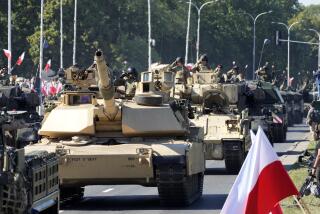Tough Talk Ignores a Disarming Reality
- Share via
Gen. Bernard Rogers, commander of North Atlantic Treaty Organization forces for eight years, told the House Armed Services Committee in December, 1986: “I am less encouraged in what has happened over the past 7 1/2 years . . . . We are practicing unilateral disarmament when, with increasing cost of new systems, we are replacing older systems with fewer numbers of new systems, even though the new systems may be more capable.”
Indeed, the numbers tell the story: We spent 75% more on aircraft during 1982-85 than we did between 1977-80, but we produced only 8% more aircraft. We spent 91% more on missiles, but got only 6% more missiles of all kinds. We spent 147% more on tanks and other armored vehicles, but got only 30% more weapons. Shipbuilding did better than most, but even here we spent 53% more and got just 36% more ships.
The 14% annual growth in the defense budget from 1979 to 1986 served to cover up some of the intrinsic deficiencies, but it also fueled the recently uncovered scandals in our weapons procurement process. The problem now is that the fantastic deficit accumulated by the Reagan Adminstration has ensured that such growth is not possible in the foreseeable future.
Disaster looms. The next secretary of defense will have to cut more than $300 billion from the current defense plan by the end of 1992 if, as seems likely, the defense budget is frozen at current levels. The Pentagon will have to slash funding from one of the three parts of the defense budget--readiness, modernization or the size of our forces.
Readiness and sustainability--our ability to engage in and sustain prolonged combat--are already underfunded. During the last eight years, the flying hours per crew per month in the Air Force, as well as the steaming days per ship per quarter in the Navy, have remained essentially constant. The miles driven per tank per year in the Army have actually declined. These figures are particularly troublesome because many of our new weapons, with their increased complexity and sophistication, require more training time than the weapons they replaced. The results of insufficient familiarity with equipment were grimly illustrated in the shooting down of the Iranian airliner by an Aegis cruiser in the Persian Gulf.
Funding for vital readiness procurement (such as spare parts, munitions and other support) declined by 28% in real terms between fiscal years 1985 and ’89. In some areas of Europe we stockpile only nine days of ammunition. Further cuts in readiness and sustainability will result in a hollow military: advanced weapons without adequate spare parts, supplies and training.
Cuts in the size of our forces leading to withdrawals from world commitments would be equally devastating. Reducing our conventional forces in Europe would be politically difficult for the next President. In the near term this seems to be the least desirable of the three options, unless the Soviets also cut their forces in Europe.
Finally, the cost of the new, modern weapons systems that the military proposes to buy in the near future is staggering. The Navy’s premier fighter, the F-14, costs $78 million per plane, and its stealthy advanced tactical aircraft is projected to cost more than $100 million per plane. Our new attack submarine, the Sea Wolf, is expected to cost more than $1 billion apiece. The Air Force is working on new versions of its F-16 and F-15, as well as an advanced tactical fighter, which it expects to cost at least $60 million per plane, probably a low estimate for a fighter that will combine the latest avionics and electronics with stealth technology. The strategic nuclear budget includes the single-warhead Midgetman missile, with an average cost of $70 million per missile; a stealth bomber whose constantly rising projected cost per bomber has passed $520 million, and a Trident submarine that will have an average cost of more than $3.5 billion. The Strategic Defense Initiative would cost hundreds of billions.
The trend toward unilateral disarmament brought about by $1,000 hammers and $50-million planes must be reversed. Because $2 trillion was spent over the last eight years on the arms race and not on real defense needs, we still lack in our arsenal an infantry weapon that can effectively stop a modern Soviet tank. It is time to recognize that we are procuring the wrong weapons. With the flat or declining military budgets of the foreseeable future caused by the huge Reagan deficit, the next generation of super-expensive weapons will be unaffordable.
This is not a partisan issue. Yet when Gov. Michael Dukakis suggests that we should not invest in all of these new weapons, Vice President George Bush questions his patriotism and knowledge of defense affairs. The American voters need to know how the candidates will deal with the looming crisis of our defenses. We need specifics, not hollow affirmations to a strong defense.
More to Read
Get the L.A. Times Politics newsletter
Deeply reported insights into legislation, politics and policy from Sacramento, Washington and beyond. In your inbox twice per week.
You may occasionally receive promotional content from the Los Angeles Times.










